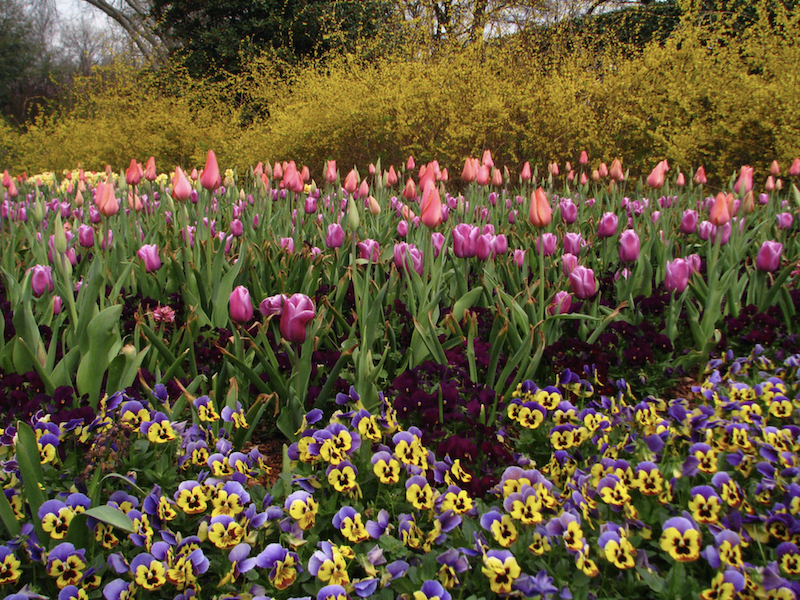One of the most recognizable shrubs when in full bloom is forsythia. The bright yellow flowers are on display early in the spring and help to usher in the later blooming shrubs and perennials. After blooming is finished, this shrub is virtually unrecognizable with its understated medium green foliage and vase shape. Forsythia is not greedy for attention other than for a few weeks in spring and is easy to include in most locations of the garden.
Ideally, this shrub needs 6 hours of full sun exposure to support vigorous growth and blooming. Well-draining soil is also key to this shrub's success. Soil that holds too much moisture is likely to cause problems, such as fungal diseases, for forsythia.

Photo by Alexander van Loon, unmodified, Flickr, copyright CC BY-SA 2.0 DEED
Placing forsythia where it can be seen from indoors during often unpredictable spring weather is a great boost to a gardener's morale while they wait for the weather to change.
Shrubs To Plant With Forsythia
Many of the favorite spring-blooming shrubs are perfect matches for forsythia. Deciduous azaleas, flowering quince, red twig dogwood, lilacs, and magnolias can form an informal flowering hedge with color for months. Evergreen shrubs also look nice with forsythia and bring color to the planting when forsythia is finished blooming. Choose from bottlebrush shrubs, boxwood, barberry, and camellias, which all grow well with forsythia in neutral, well-drained soil. For later-season color, plant forsythia with beautyberry, rose of Sharon, California lilac, and many types of hydrangea. The blooms will look lovely against the solid green foliage of forsythia.
Perennials To Plant With Forsythia
Spring blooming bulbs like daffodils, tulips, grape hyacinths, snowdrops, and lily of the valley make nice groundcovers for forsythia either before or while it is in bloom. Later in the spring, Solomon’s seal, monkshood, and bleeding hearts can be used to fill in the garden bed. Clematis can be encouraged to ramble through a forsythia after blooming with no fear of it overwhelming the shrub. For large forsythias, use Siberian iris, Italian arum lily, and crocosmia to spread as a groundcover and remain prominent next to larger plants. Forsythia left to grow at the edges of a property can be incorporated into a wildlife area and underplanted with pollinator-attracting plants and native grasses.

Photo by Jennifer Yang
Annuals To Plant With Forsythia
Hardy early spring annuals are a great choice to plant with forsythia. Pansies, violas, snapdragons, and petunias in bright and cheerful colors will coordinate with the bright yellow of most forsythia varieties. Summer annuals can be planted as a weed-suppressing groundcover and living mulch for forsythia. Select from impatiens, geraniums, alyssum, calendula, french marigolds, and flowering vinca, which can grow in sun and bloom long into fall.
Best Companion Plants For Forsythia in Containers
Dwarf and miniature varieties of forsythia will happily grow in a pot for many years before needing to be transplanted into the garden. Forsythia also makes a lovely flowering bonsai to grow indoors or outside. Underplant forsythia with an array of spring bulbs to bloom all spring. Treating the bubs like annuals means that the planting can be changed every year if the gardener wishes. Pansy, viola, and primrose are also excellent options for early spring color in a mixed seasonal planting. For a no-fuss design, plant Creeping Jenny and English ivy around forsythia to spill over the sides and soften the edges of the planter.
Plants Not To Grow With Forsythia
Forsythia does not tolerate soils that stay waterlogged or experience seasonal flooding. Avoid planting forsythia with cattails, marsh marigolds, flag iris, and waterlilies, which require constantly wet conditions to grow well. Similarly, xeric or desert plants are not a good match either. Cacti, succulents, yucca, and paddle cacti all require drier conditions than forsythia can tolerate.
Best Plants To Grow With Forsythia
Forsythia looks best when it is planted in a naturalistic garden setting with other early spring bloomers. It looks best when left to develop its natural shape, but large varieties may require a wide spacing between plants to reach their mature size. To accent forsythia’s sunny yellow color, include Magnolia stellata, daffodils, and arum lilies in your design. Adding later blooming crocosmia and iris will continue to provide bold color long after the forsythia has finished blooming.
 |
Author Robbin Small - Published 10-05-2023 |
